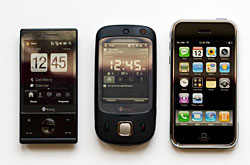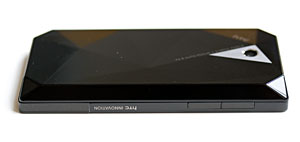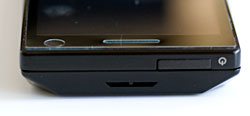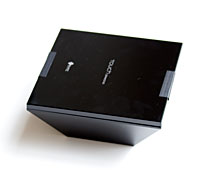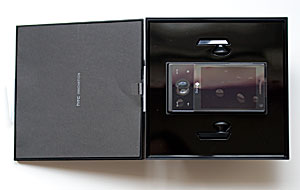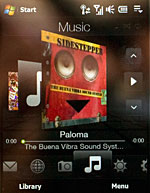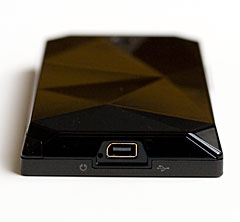
|
||||||||||||||||
First off, TouchFLO 3D covers only the following tasks/applications: home screen (with the usual TouchFLO large clock, list of appointments, call history, date, time and carrier), speed dial (visual with photo caller ID pictures you can flip through rather than a list), SMS text messages (threaded thanks to Windows Mobile 6.1), email, locally stored music playback, camera and photo viewer (all in the same pane), Opera web browser with a list of bookmarks (very convenient), weather (for 6 cities), a selection of core settings and an icon-based application launcher. For these tasks, excluding HTC's weather and custom home screen which are only found on HTC's touch line, TouchFLO 3D is an improvement over vanilla Windows Mobile Professional. For power users using 3rd party home screens with launchers or those who own TouchFLO classic devices the gap narrows. The Diamond does it prettier but generally not faster. Second, there's occasional lag, though we'd say that HTC did an admirable job of hardware and software graphics acceleration and as a result, the UI is much faster than you'd expect from Windows Mobile. But nonetheless, there are pregnant pauses here and there, and that second it takes the device to draw the tab you've selected. To see the TouchFLO 3D interface in action, watch this short video: Now our qualms: there are places you should touch and drag or swipe, and places you shouldn't for best performance. What's up with that? It's open season on every pixel with other touch screen phones and devices. You see an icon strip at the bottom and you figure you should swipe your finger across it to scroll through the icons. Nope, it will be slow, jerky and oddly behaved. You must grab the current (slightly larger) icon representing the active tab and drag it to move through the icon list. Do it this way, slow or fast, and the UI keeps right up (other than that 1-2 seconds it takes to draw the tab you end up at). Why? Who knows. There's a welcome video that plays on the device and the hand model does it this way, but it just might not register that you really have to do it this way. Dig out the 10 meg PDF manual and it clues you in (the box is too small to fit a printed manual). Or look not at the pint-sized getting started guide but at the unlabeled accordion fold-out pamphlet (also small so it fits at the bottom of the inverted pyramid shaped box) where it mentions this. The best UI requires little if no perusing of manuals-- while TouchFLO 3D is a work of art and effective once you master its tricks, it's not brain-dead intuitive (think of the LG Prada, LG Vu, Samsung Instinct and iPhone where you simply tap on an icon or drag and scroll at will pretty much anywhere). Now that you've got this simple concept down, throw it away when using finger gestures in each pane of TouchFLO 3D's UI: drag, swipe and scroll anywhere in the album cover (music) screen, weather screen or mail message inside its virtual account envelope (though the required smaller up or down flick for mail messages is a little tricky for emails and it's too easy to open an email rather than scroll past it). Lastly, unlike every other Windows Mobile 5 and 6 Pro (Pocket PC) phone, there's no way to switch between portrait and landscape mode. Yes, the device uses the accelerometer to rotate the display automatically in the photo viewer and Opera, but there's no way to set it system wide so we found ourselves stuck with portrait mode for Excel mobile, Word Mobile, NetFront 3.5 and so on. Major bummer, dude. That also means you're stuck using the more cramped portrait orientation keyboard everywhere except the web browser. We do like HTC's enlarged QWERTY on-screen keyboard but the keys are still a bit small and the keyboard covers most of the screen so you often can't see what you're typing. Note: the SKTools folk have made a free application that wil rotate the screen using the accelerometer in any application (except HTC Home, Teeter and a few other places) that you can download here. Fun UI stuff and interesting Diamond party tricks: - Want to silence that incoming call ringer? Pick up the phone and place it face down on the table. - The accelerometer or G-sensor as HTC calls it, keeps the phone in touch with its orientation; so like the iPhone, simply turn it to landscape mode if you want to do any task in landscape mode. It supports 3 orientations- right and left landscape and portrait (there's no upside down portrait mode). - The stylus lives in a silo at the bottom right corner and it's held in place by a small magnet-- insert it part way and the phone gently sucks it all the way in. - Though the front buttons are mechanical buttons nested under the smooth front face, the d-pad is electrostatic which means you can swirl your finger around its perimeter to move forward in a music track and zoom in the photo viewer, Word mobile and a few other apps. - You must try the included game, Teeter! It's a blast and it really shows off HTC's keen engineering along with the very accurate accelerometer. Teeter is similar in concept to the game (physical game, not computer game) Labyrinth where you must tilt the device in all directions to get a small metal ball through a maze littered with holes. The phone actually varies vibration feedback when the ball bounces off the walls, matching ball speed with the resulting strike force. Speaking of the Box Normally we don't get into the whole unboxing schtick, but we'll make an exception for the Diamond, whose packaging is both beautiful and unique.
In the box you'll find a world charger with a new design (but same amp/volt and connector as other recent HTC devices), stereo earbud headset with a special diamond design, USB cable, software CD, manuals (some tiny since they have to fit into the bottom of the box) and a screen protector. Phone The Touch Diamond is a quad band GSM phone that supports the 850/900/1800/1900MHz bands. It has GPRS, EDGE and HSDPA 3G, but 3G will not work in the US since it doesn't support our 3G bands. We tested the Diamond for a week with a T-Mobile US SIM and an AT&T SIM. Phone reception on T-Mobile's 1900MHz band was very good and data transfers on EDGE garnered an average 90kbit/sec according to DSL Reports mobile speed test. AT&T managed 150k on average. Call quality has been very good for us on both incoming and outgoing ends, and volume is average. The speakerphone is OK, sounding a bit thin and not terribly loud; but sound through the included stereo earbud headset (designed to match the Diamond's looks) is excellent and loud. As you'd expect, the phone works with Bluetooth headsets and quality with the Jawbone and Plantronics Discovery 655 was good. The phone uses Cyberon Voice Speed dial, which uses voice tags for voice-activated calling. This works with Bluetooth headsets and directly with the phone (press and hold the call send button to activate voice dialing). HTC's own speed dial pane (called "People") uses caller ID photos (or stock head silhouette icons if you have no photo) with the person's name below (otherwise those generic silhouettes wouldn't get you far). You can flip through these like album covers or scroll through the micro caller ID icons on the right side. Performance The Diamond has a fast CPU: the Qualcomm MSM7201A running at 528MHz. HTC tells us they're also using hardware and software graphics acceleration to power TouchFLO 3D. TouchFLO 3D makes direct comparisons to other Windows Mobile Professional phones difficult because it does affect device speed overall. It's running in the background even when using any of the standard Windows Mobile applications, scrolling through the Programs group (which has the standard UI) or opening menus (HTC touches the start menu with an enlarged font option). The Diamond's UI is at times very quick but it bogs down a bit here and there, then recovers most of the way. It's never as fast as the Touch Dual running TouchFLO classic but it's often fast enough to be very pleasant nonetheless. We tested the device in standard mode-- you can turn off TouchFLO 3D, and it was a bit snappier than the TyTN II (Tilt), even with several programs running.
The music pane in TouchFLO 3D with album art, play and track skip buttons. The HTC Diamond has 256 megs of flash ROM, 192 megs of RAM (apportioned as 128 and 64 meg partitions with only the 128 meg partition visible via the Memory applet) and 4 gigs in internal flash memory that's treated as a large storage card. There is no microSD card slot, a drawback for those who like to carry several large cards loaded with song sets, movies and more. The Diamond has USB drive mode (USB 2.0 high speed), so you can copy files to the phone just as simply as with a card reader. Just plug in the cable and copy. You can sync songs and playlists to the phone using Windows Media Player on the desktop, but we found album art didn't transfer. You'll either have to copy album art to the phone manually or use a 3rd party program.
The HTC Diamond has approximately 55 megs of RAM free at boot, which is a bit low compared to other 128 meg and above WinMo phones. Likely TouchFLO 3D needs RAM at boot and there may be some application caching of the programs accessed via the TouchFLO panes. There are 85 megs of flash memory (storage memory), though some of this is used by HTC's apps installed at first boot. Our unit had about 60 megs free. Booting takes a long time: 1 minute 18 seconds from a press of the power button until the device is ready to use. After the Windows Mobile startup screen passes, you'll see a screen that says "touch here to start TouchFLO 3D". Even if you don't touch the screen, TouchFLO 3D launches; if you do touch the screen it launches no faster-- so why is it there? Internet Opera 9.5 Mobile (not yet available for download or separate sale for other devices as of this writing) has improved leaps and bounds. We loved it on the HTC Advantage X7510, but alas, it's better suited to the Advantage's much larger VGA display. Text in the initial view is nearly greeked, making the desktop rendering impressive but less than effective on the Diamond's 2.8" VGA display. You can drag the page around to scroll and zoom in by tapping. This means you can rarely visit a home page and start reading immediately, you'll need to zoom in first, then drag the page as needed. Opera is buggy and slows down the device itself, a problem we haven't encountered with the Advantage. Of the phone's 192 megs of total RAM, 64 are set aside for special use, and one of these is Opera which needs lots of memory. Yet the app, even after quitting completely, leaves us with a seemingly confused and sluggish Diamond. After exiting we've seen the taskbar never redraw correctly (elements are missing) and TouchFLO 3D re-launch itself. A reboot (press and hold the power button to shut down completely, then press it again to power up) fixes these problems. Once the bugs are worked out and speed is improved (even Opera itself slows down), web browsing will be a pleasure as long as you don't mind zooming and scrolling. The page layout is superb and approaches the iPhone's desktop fidelity, it supports multiple windows, Javascript, most dHTML and the usual assortment of standard features such as cookies, history, cache control and full-screen view. And yes, Internet Explorer mobile is there too and it's quite speedy on the Diamond-- we recommend it when speed counts more than desktop fidelity.
The Diamond playing the welcome video. Email is the usual Windows Mobile Messaging (the WinMo equivalent of Outlook), unchanged other than the pretty home screen pane with its envelopes stuffed full of mail. It handles POP, IMAP and Exchange email and can do Direct Push if you're connecting to Exchange Server 2003 SP. 2 or newer. HTML support in email comes only when using Exchange 2007. There's a threaded SMS app and the phone can send MMS. SMS text messaging was a little quirky: though set to play a sound when a new text message came in, the Diamond didn't wake up or play a sound. A second or 2 after we turned the device on, it notified us of the new SMS. HTC includes Ilium Software's RSS Hub for your news feed reading pleasure. You can install your favorite 3rd party Internet apps like NetFront, Opera Mini and more. We found NetFront 3.5 preview ran slower on the Diamond than on our HTC Touch Dual, Advantage and E-TEN Glofiish X800, but it was certainly usable. Like most HTC devices, the Touch Diamond comes with Esmertec's Jbed Java VM so you can run Opera Mini and other Java applications. The Diamond features a dedicated YouTube application that works with the full version of the YouTube site and plays FLV Flash videos. The VGA display means the video fits on screen unlike the QVGA N95 which can also play FLV YouTube files. Plan on using WiFi or HSDPA (for you overseas folks) because EDGE is too slow. Even on an 802.11g connection, video playback stutters and degrades but is certainly watchable. GPS The HTC Diamond has an internal GPS that works with Google Maps, Windows Live Search, CoPilot 7 and other GPS applications. It does not ship with any navigation software other than the QuickGPS utility. QuickGPS downloads satellite data from the Internet every 7 days and the GPS uses this data to speed up positioning. We tested the Touch Diamond with Google Maps and Windows Live Search, both of which worked with the default Windows Intermediate driver setting for the GPS port (we did have to reboot the device here and there to get these apps to find the GPS, but once they found it, we never had a problem again. This isn't a killer SiRF III GPS, so don't expect to get a 3D fix from an interior room in your house, but reception is fine outdoors in suburban locations and even in downtown Dallas which has a fair number of tall buildings (we can't speak of reception in a place like mid-town Manhattan, which is GPS hell). The GPS was accurate and updated location quickly using Google, Live Search and CoPilot. No complaints. Camera HTC's cameras haven't been their strong point, even when they look good on paper. The 3 megapixel autofocus camera on the original Advantage X7501 didn't take very good pictures, and the Tilt's camera was just OK. The Diamond changes that, with sharper pictures that show clarity, good saturation and color balance. The autofocus lens is quick by camera phone standards and definitely improves image quality compared to a fixed focus lens; something we couldn't say as a rule for HTC's cameras before the Diamond. We still see too much sharpening in landscape shots leading to fractal-like leaves and overstated water reflections, but sharpening can be tweaked under advanced settings. The lens has a large max aperture of f2.8 and indoors it's wide open which means you'll see a good deal of motion blur. The camera can take photos at medium, large, 1 meg, 2 meg and 3 meg resolutions (why HTC mixes "medium" and megapixel settings we don't know). Large translates to VGA and medium is QVGA. 3 meg is the highest resolution and it takes photos at 2048 x 1536 pixels. There are modes for camera, video, panorama, contacts picture, MMS video and themed photos (with a photo frame border). Video resolutions are CIF, small, medium and large. MMS photos are recorded in 3GP format and standard video (for saving, not sending via MMS) is recorded in an MP4 format that's compatible with Windows Media Player on the desktop but not Quicktime. QVGA 320 x 240 @ 15fps is the highest resolution option and video is blocky and has a great deal of ghosting unless you and your subject stay still.
These sample photos were taken at the highest resolution. Click on a photo to see a larger version in a new window. Battery The Touch Diamond comes with a charger that's designed to esthetically match the phone-- shiny and angular. It's the same 1 amp .5 volt charger spec and HTC ExTUSB connector as other recent HTC devices, so you can use those chargers too. The USB cable plugs into the charger and there is no longer a permanently wired cable coming from the charger (likely saving on manufacturing cost). The phone has a 900 mAh battery that lives under the back door (the entire back door slides off, just like the Touch). That sounds like a low capacity battery for a powerful smartphone with 3G, WiFi and GPS, but battery life was better than we expected. Granted, we could only run the phone on EDGE here, which uses less power than 3G, but the phone lasted us through the day as long as we didn't rely heavily on WiFi (which is a great temptation when the alternative is EDGE). If you plan to use WiFi much or the GPS, you'll probably want a spare battery. Otherwise with moderate to moderately heavy use, the Diamond lasted us from 9am to 9pm on a charge. The phone gets warm when it's working hard at tasks like playing videos stored on internal memory and streaming YouTube video. The battery gets warm but not hot when charging. Conclusion We applaud the HTC Touch Diamond for its ambition and promise. With the Sony Ericsson Xperia coming and the Samsung Omnia i900 now on the market as an import, offering their own customizations of Windows Mobile 6.1's UI and widescreen displays, the competition will be getting a little fierce. We love the small size and gorgeous design, though this is a phone Adrian Monk would loathe given its propensity to collect stubborn fingerprints. TouchFLO 3D is definitely fun and interesting, though it doesn't always translate into a more efficient and expedient UI. We wish you didn't have to read the manual to learn the in's and out's of finger navigation (isn't the point of touch phones that they should operate nearly transparently), though first time WinMo users will likely find the visual presentation easier to figure out than standard WinMo. However, in terms of price and features the Diamond is a high-end power user's phone, and those generally attract veteran users who may grow frustrated with the visuals when wanting to accomplish tasks quickly. Certainly, the feature set is incredible-- VGA display, GPS, WiFi, Bluetooth, 4 gigs of storage and a good autofocus camera. And it's a marvel that HTC fit all this in such a slim, small and light device. Based on the hardware, the Diamond is indeed a gem. Pro: TouchFLO 3D is gorgeous to behold and mostly very functional. It may not always be the fastest way to navigate the phone's functions, but it makes doing it fun. Fantastic feature set in a small, thin and light phone. Awesome good looks (just keep that microfiber cloth handy). VGA display is sharp and bright. USB mass storage mode works perfectly for transferring files and speed is good. Phone reception is very good and voice quality is solid. Music sounds great over Bluetooth stereo headphones and WiFi range is better than average for a PDA phone. Con: For US users, the lack of US 3G bands is limiting. No usual landscape support in Windows Mobile, Office mobile or anywhere else except the supported applications like the photo album, video player and Opera. TouchFLO 3D needs a few tweaks to improve usability (though we're impressed overall). Opera seems to be a resource hog and slows down the device, even after exiting it. Phone screen turns off almost immediately after starting a call, presenting challenges when calling automated systems that use keypad input. Lack of an expansion slot will cramp those who want to use it as a media player and switch cards full of songs and videos. Web site: www.htc.com Price: Currently around $660- $700 from importers.
| ||||||||||||||||

